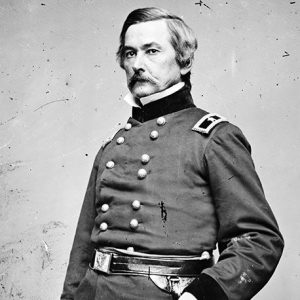calsfoundation@cals.org
Skirmish at St. Francis Road
| Location: | Phillips County |
| Campaign: | Vicksburg Campaign |
| Date: | December 23, 1862 |
| Principal Commanders: | Brigadier General Willis A. Gorman (US); Unidentified (CS) |
| Forces Engaged: | Unidentified (US); Unspecified Texas cavalry (CS) |
| Estimated Casualties: | 2 killed, 16 wounded (US); None reported (CS) |
| Results: | Tactical Confederate victory; Strategic Union victory |
This brief engagement in Phillips County occurred in relation to some of the earliest Federal operations against Vicksburg, Mississippi.
Brigadier General Willis A. Gorman, commander of the District of Eastern Arkansas headquartered at Helena (Phillips County), reported that an unspecified unit of Texas cavalry had attacked a Federal outpost of pickets on the St. Francis Road near Helena on December 23, 1862. Casualties at the outpost included two Federal soldiers killed and sixteen wounded, with no report of Confederate losses. Federal cavalry vigorously pursued the Texans and forced them to scatter in order to make their final escape through a patch of woods.
Although unidentified in the official reports, the attack may have been conducted by Captain Alfred Johnson’s Company “E” (also known as Johnson’s Texas Spy Company) of Lieutenant Colonel Charles Leroy Morgan’s Texas Cavalry Battalion, as Capt. Johnson’s Company operated in this area of eastern Arkansas at the time and recently engaged in similar attacks on Federal troops.
The Confederates apparently hoped that such attacks would disrupt Federal communications across the Mississippi River with Major General Ulysses S. Grant during early operations against the citadel of Vicksburg, Mississippi. According to Gorman’s report, Grant’s concerns over the security of Trans-Mississippi communications, especially in relation to the recent activities of such Texas cavalry units, influenced him to request that Gorman employ 2,000 Federal cavalry to ensure that communications remained open across the river. Although Gorman believed that the aggression of the Texas cavalry would indeed continue and even increase in that area, he also expressed the opinion that such attacks would produce no result relative to the campaign against Vicksburg other than annoyance.
Designed as a hit-and-run operation undertaken by a relatively small force, rather than an attempt to permanently drive the Federals out of the area, the Texas troopers surprised the Federal outpost, inflicted lopsided casualties, and made a successful withdrawal with no known casualties among their number. They failed, however, to cause even a temporary disruption of Federal communications across the Mississippi River. The Skirmish at St. Francis Road, therefore, represents a tactical Confederate victory and a strategic Union victory.
For additional information:
Bailey, Anne J. Between the Enemy and Texas: Parsons’s Texas Cavalry in the Civil War. Fort Worth: Texas Christian University Press, 1989.
Hanna, H. L. The Press Covers the Invasion of Arkansas, 1862, Vol. 2 (July–December). Widener, AR: Southern Heritage Press, 2012.
The War of the Rebellion: A Compilation of the Official Records of the Union and Confederate Armies. Series 1, Vol. 22, part 1. Washington DC: Government Printing Office, 1888.
Robert Patrick Bender
Eastern New Mexico University–Roswell


 ACWSC Logo
ACWSC Logo  Willis A. Gorman
Willis A. Gorman 



Comments
No comments on this entry yet.